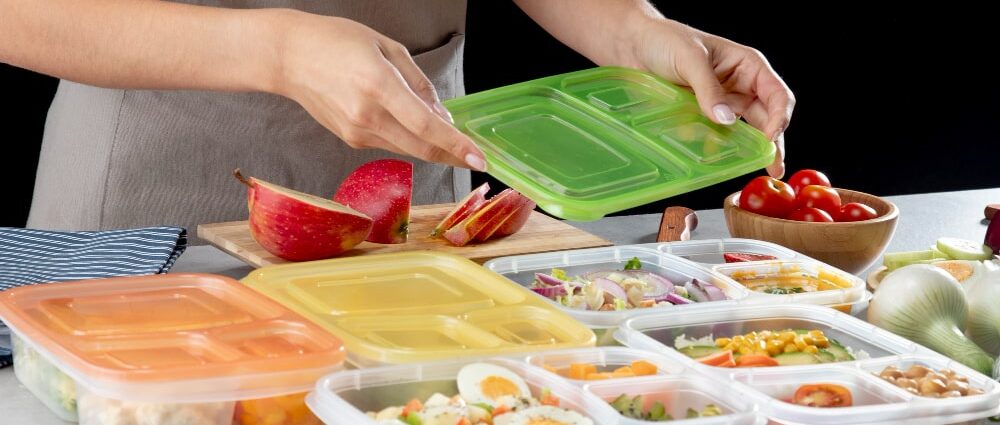Wasting food isn’t just about throwing money away—it’s also a big environmental problem. When food goes uneaten, all the water, energy, and labor that went into producing it is wasted, too. Plus, food waste contributes to greenhouse gas emissions when it rots in landfills.
In our home, cutting back on food waste has been a game-changer. Not only do we save money, but we also make the most of everything we buy, get creative with leftovers, and always have something tasty on hand.
Reducing food waste means:
✔ Saving money by using what you have
✔ Making grocery shopping more efficient
✔ Lowering your carbon footprint
✔ Reducing clutter in your fridge and pantry
Many people assume that avoiding food waste means eating the same meals over and over, but that’s not the case. With a little planning, smart storage, and some creativity, you can use up every last bit without getting bored.
How Meal Planning Helps Reduce Food Waste
Meal planning is one of the simplest ways to cut down on waste. When you have a plan, you buy only what you need, use ingredients more efficiently, and avoid last-minute grocery runs that lead to impulse purchases.
Here’s how I keep meal planning easy and stress-free:
- Plan meals around what you already have. Before writing a shopping list, I check my fridge and pantry to see what needs to be used up.
- Choose versatile ingredients. Foods like rice, beans, eggs, and vegetables can be used in multiple meals, making it easier to avoid waste.
- Schedule “leftover nights.” At least once a week, I skip cooking and turn leftovers into new meals.
- Be realistic. If I know we’ll have a busy night, I don’t plan an elaborate meal—I opt for something simple or a freezer meal instead.
By planning ahead, I not only waste less but also save time and money throughout the week.
Smart Storage Hacks to Keep Food Fresher Longer
Proper storage is the key to making food last. Over the years, I’ve picked up a few tricks that keep produce, dairy, and pantry staples from spoiling too soon.
For Fruits and Vegetables:
- Store leafy greens with a paper towel. It absorbs moisture and keeps them crisp.
- Keep berries in a breathable container. A glass jar or a container with ventilation prevents mold.
- Separate ethylene-producing fruits. Bananas, apples, and avocados release a gas that speeds up ripening—keep them away from other produce.
For Dairy and Eggs:
- Keep milk and yogurt on the middle shelf. The door is too warm and can cause spoilage.
- Flip cottage cheese and sour cream containers upside down. This creates a vacuum seal that slows bacterial growth.
- Store eggs in their original carton. This helps them last longer by preventing moisture loss.
For Pantry Staples:
- Use airtight containers for dry goods. Flour, sugar, and grains stay fresh longer when sealed properly.
- Label and date everything. This prevents forgotten items from expiring at the back of the shelf.
- Rotate stock. Use the “first in, first out” method to avoid old food lingering.
Taking a few extra minutes to store food properly can make a huge difference in how long it lasts.
Creative Ways to Use Leftovers
One of the biggest challenges with food waste is knowing what to do with leftovers. Instead of reheating the same meal repeatedly, I like to get creative and turn leftovers into something new.
Some of my favorite ways to repurpose food:
- Roast chicken → Chicken tacos, salad, or soup
- Leftover rice → Fried rice or rice pudding
- Overripe bananas → Banana bread, pancakes, or smoothies
- Stale bread → Croutons, French toast, or breadcrumbs
- Vegetable scraps → Homemade broth or stir-fry
Leftovers don’t have to be boring. With a little creativity, they can become completely new meals.
How I Cut Down on Food Waste Every Week
Reducing food waste isn’t about perfection—it’s about making small, consistent changes. Here’s what I do every week to stay on track:
✔ Check the fridge before grocery shopping. I plan meals around what I already have.
✔ Freeze extra portions. If I make a big batch of soup or stew, I freeze some for a future meal.
✔ Use a “Eat First” bin. I keep a small bin in the fridge for items that need to be eaten soon.
✔ Compost scraps. Any peels, stems, or leftovers that truly can’t be used go into the compost.
By keeping food waste top of mind, I’ve been able to save money and make the most of every ingredient.
Final Thoughts: Why Reducing Food Waste is Worth It
Cutting down on food waste has saved me money, made meal planning easier, and helped me get more creative in the kitchen. It’s not about giving up the foods you love—it’s about using them wisely.
If you’re looking to reduce food waste in your home, start small. Plan your meals, store food properly, and find creative ways to use leftovers. Every little effort adds up.
How do you reduce food waste in your home? I’d love to hear your tips.
FAQs
What are the easiest ways to reduce food waste?
Start with meal planning, proper storage, and using leftovers creatively. Freezing food before it spoils is also a great strategy.
How long do leftovers last in the fridge?
Most leftovers are safe for three to four days if stored properly. If you’re unsure, freezing them is a good option.
How can I store herbs to keep them fresh longer?
Wrap them in a damp paper towel and store them in a sealed bag in the fridge. Alternatively, you can freeze chopped herbs in olive oil using an ice cube tray.
What should I do with food scraps?
Vegetable peels and scraps can be used for homemade broth, while fruit scraps can be turned into infused water or composted.
Can I eat food past its “best by” date?
Yes, in many cases. “Best by” dates are not expiration dates but quality indicators. Trust your senses—if the food looks and smells fine, it’s often still good to eat.
Suggested Links:

